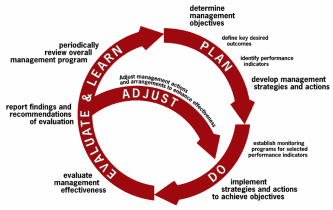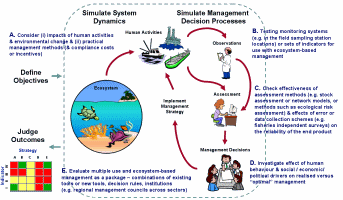Management
Strategy Evaluation
Introduction
Management strategy evaluation (MSE) in the broad sense involves
assessing the consequences of a range of management strategies
or options and presenting the results in a way which lays bare
the tradeoffs in performance across a range of management objectives.
In contrast to some previous approaches to fisheries assessment,
it does not seek to proscribe an optimal strategy or decision.
Instead it seeks to provide the decision maker with the information
on which to base a rational decision, given their own objectives,
preferences, and attitudes to risk.
MSE is a simulation technique based on modelling
each part of the adaptive management cycle (Figure 1). It was developed
more than 20 years ago to consider the implications of alternative
management strategies for the robust management of natural resources,
such as single fish stocks. Two very useful reviews of the subject
are Butterworth and Punt (1999) and Sainsbury et al. (2000).

Figure
1: Adaptive management cycle
(Click to enlarge in new window) [1] |
The method
has been used by bodies such as the International Whaling Commission
(e.g. IWC 1992, Kirkwood 1997) and Commission for the Conservation
of Antarctic Marine Living Resources (CCAMLR) (de la Mare 1996)
and has been adopted as a standard fisheries tool in a number of
countries including: South Africa (Punt and Butterworth 1995, Cochrane
et al 1998, Butterworth et al 1998), Europe (Horwood 1994, as of
Butterworth and Punt 1999), New Zealand (Starr et al. 1997) and
Australia (Punt and Smith 1999).
The strength
of the approach is that instead of using a single model to find
an optimal solution, multiple candidate models are put forward
to evaluate alternate hypotheses. By modelling each step of the
formal adaptive-management approach (Walters 1986) the consequences
of alternate scenarios can be evaluated across the models. The
other core strength of the process is that it is consultative
- both managers and stakeholders can have input into the candidate
models and management scenarios. As the approach demands clear
objectives to do the evaluations against, the method forces participants
to be clear about their objectives and to specify performance
indicators that are in the context of what people are interested
in.

Figure 2:
MSE cycle and questions
(Click to enlarge in new window) |
MSEs can
be performed qualitatively (Smith et al 2005), but they have
typically been done using quantitative (or at least semi-quantitative)
simulations that contain sub-models for each of the main steps
in the adaptive management cycle. At the core of these simulations
is a "system state" model that represents the dynamics
of the resource. As the models were initially used to consider
single species fisheries management issues the earliest MSE models
included single species models (e.g. IWC 1992), or single species
with habitat considerations (e.g. Plectropomus leopardus and
reef habitat in ELSIM, Mapstone et al. 2004). It was not long
however, before they were being applied to multispecies questions
(e.g. 3 species hake and seal model used by Punt and Leslie 1995,
or the four species and habitat modelled by Sainsbury 1988).
More recently ecosystem-based management and multiple use management
questions have been addressed using the MSE approach. Atlantis and InVitro are
two models developed by staff in the CSIRO Marine and Atmospheric
Research Division to consider ecosystem-level management questions
using the MSE approach. Ecopath with Ecosim (developed at the
Fisheries Centre at the University of British Columbia, Vancouver)
has also been used in an ecosystem-level MSE (e.g. the overlap
of seals and fisheries off Macquarie Island, Goldsworthy et al.
2001). Quite a wide range of questions can be addressed using
these models (Figure 2).
References:
Walters, C.J., 1986. Adaptive Management of Renewable
Resources. MacMillan Publishing Co., New York.
Sainsbury, K. J. (1988). The ecological basis of
multispecies fisheries, and management of a demersal fishery in
tropical Australia. In: Gulland, J. A. (Ed.), Fish population dynamics,
(2nd ed.), Chapter 14, pp.349-82, John Wiley & Sons Ltd.
IWC 1992. Report of the Scientific Committee, Annex
D. Report of the Sub-Committee on Management Procedures. Reports
of the International Whaling Commission, 42: 87–136.
Smith, A.D.M. (1994) Management strategy evaluation
- the light on the hill. Pp 249-253 in D.A. Hancock (Ed.) Population
Dynamics for Fisheries Management. Australian Society for
Fish Biology Workshop Proceedings, Perth, 24-25 August 1993. Australian
Society for Fish Biology, Perth.
Punt and Butterworth 1995: Punt, A.E. and D.S. Butterworth.
1995. The effects of future consumption by the Cape fur seal on
catches and catch rates of the Cape hakes. 4. Modelling the biological
interaction between Cape fur seals Arctocephalus pusillus pusillus
and Cape hakes Merluccius capensis and M. paradoxus. S. Afr. J.
mar. Sci. 16: 255-285.
de la Mare, W. K. 1996. Some recent developments
in the management of marine living resources. In Frontiers of Population
Ecology, pp. 599–616. Ed. by R. B. Floyd, A. W. Shepherd,
and P. J. De Barro. CSIRO Publishing, Melbourne, Australia.
Kirkwood, G. P. 1997. The Revised Management Procedure
of the International Whaling Commission. In Global trends: fisheries
management, pp. 41–99. Ed. by E. K. Pikitch, D. D. Huppert,
and M. P. Sissenwine. American Fisheries Society Symposium, 20,
Bethesda, Maryland.
Starr, P. J., Breen, P. A., Hilborn, R. H., and Kendrick,
T. H. 1997. Evaluation of a management decision rule for a New
Zealand rock lobster substock. Marine and Freshwater Research,
48: 1093–1101.
Butterworth, D. S., Cowan, C. L., and Johnston, S.
J. 1998. The development of a management procedure for Namibian
seals. Report to the Ministry of Fisheries and Marine Resources,
Namibia. 47 pp.
Cochrane, K. L., Butterworth, D. S., De Oliveria,
J. A. A., and Roel, B. A. 1998. Management procedures in a fishery
based on highly variable stocks and with conflicting objectives:
experiences in the South African pelagic fishery. Reviews in Fish
Biology and Fisheries, 8: 177–214.
Butterworth, D.S., and Punt, A.E. 1999. Experiences
in the evaluation and implementation of management procedures.
ICES Journal of Marine Science, 56: 985–998.
Punt, A. E., and Smith, A. D. M. 1999. Harvest strategy
evaluation for the eastern gemfish (Rexea solandri). ICES Journal
of Marine Science, 56: 860–875.
Sainsbury, K.J., Punt, A.E. and Smith, A.D.M. 2000.
Design of operational management strategies for achieving fishery
ecosystem objectives. ICES Journal of Marine Science, 57: 731–741
Goldsworthy,
S.D., He, X., Tuck, G.N. Lewis, M. and Williams, R. 2001. Trophic
interactions between the Patagonian toothfish, its fishery, and
seals and seabirds around Macquarie Island. Marine Ecology Progress
Series, 218: 283-302.
Mapstone B.D., Davies C.R., Little L.R., Punt A.E.,
Smith A.D.M, Pantus F., Lou D.C., Williams A.J., Jones A., Ayling
A.M., Russ G.R., and McDonald A.D. 2004. The Effects of Line Fishing
on the Great Barrier Reef and Evaluations of Alternative Potential
Management Strategies. CRC Reef Research Centre Technical Report
No 52. CRC Reef Research Centre, Townsville, Australia.
Jones, G, 2005, Is the management plan achieving its objectives? pp555-557 In Worboys, G, Lockwood, M, & De Lacy, T, Protected Area Management. Principles and Practice. Second edition. Oxford University Press. Available online at http://www.parks.tas.gov.au/index.aspx?base=7679
Figure 1 References:
Jones, G, 2005, 'Is the management plan achieving its objectives?'
pp555-567 in Worboys, G, De Lacy, T. & Lockwood, M. (eds) Protected Area
Management. Principles and Practices. Second Edition. Oxford
University Press. Case study available online
(http://www.parks.tas.gov.au/index.aspx?base=7679).
Jones, G, 2009, 'The adaptive management system for the Tasmanian
Wilderness World Heritage Area-linking management planning with
effectiveness evaluation'. Chapter 13 in Allan, C. and Stankey, G.
(eds), Adaptive Environmental Management. A Practitioner's Guide.
Co-published by Springer and CSIRO Publishing, 351p. Dordrecht The
Netherlands & Collingwood Australia.
www.springerlink.com. Chapter 13
available online at http://www.parks.tas.gov.au/index.aspx?base=15123.
Last updated:
21/03/13
|  |